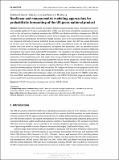| dc.contributor.author | Arora, Siddharth | |
| dc.contributor.author | McSharry, Patrick E. | |
| dc.contributor.author | Little, Max | |
| dc.date.accessioned | 2014-06-05T12:59:41Z | |
| dc.date.available | 2014-06-05T12:59:41Z | |
| dc.date.issued | 2013-06 | |
| dc.identifier.issn | 1558-3708 | |
| dc.identifier.issn | 1081-1826 | |
| dc.identifier.uri | http://hdl.handle.net/1721.1/87639 | |
| dc.description.abstract | Numerous time series models are available for forecasting economic output. Autoregressive models were initially applied to US gross national product (GNP), and have been extended to nonlinear structures, such as the self-exciting threshold autoregressive (SETAR) and Markov-switching autoregressive (MS-AR) models. We show that while these nonlinear models fit the in-sample data better than linear models, the out-of-sample forecast performance of extremely simple methods, such as the unconditional mean is competitive compared with both previously published linear and nonlinear models for GNP time series. Motivated by Occam′s razor and the forecasting competitiveness of the unconditional mean, we seek parsimonious models which are based on simple assumptions, incorporate few parameters, and can generate accurate forecasts. We propose nonlinear and nonparametric models based on nearest neighbor and kernel regression by forming a state-space of time delayed GNP observations. The rationale of the proposed methodology lies in identification of local regions of state-space known as nearest neighbor sub-spaces, whereby we utilize future trajectories of the neighboring states and weight them using a double kernel estimator to generate density forecasts. The models proposed in this work incorporate only one or two parameters, and the model estimation framework relies on optimizing the performance of in-sample density forecasts. The proposed modeling approach does not require prior assumptions regarding the form of the error distribution, and can provide transition between regimes of growth and contraction. We compare the forecasts from proposed models with classical time series models for GNP and a range of benchmarks, and validate our results on two post-war GNP time series using different performance scores, such as the root mean squared error (RMSE), mean absolute error (MAE), and the continuous ranked probability score (CRPS). We find that proposed models consistently outperformed previously published models for point and density forecasts of GNP at varying horizons. | en_US |
| dc.language.iso | en_US | |
| dc.relation.isversionof | http://dx.doi.org/10.1515/snde-2012-0029 | en_US |
| dc.rights | Article is made available in accordance with the publisher's policy and may be subject to US copyright law. Please refer to the publisher's site for terms of use. | en_US |
| dc.source | De Gruyter | en_US |
| dc.title | Nonlinear and nonparametric modeling approaches for probabilistic forecasting of the US gross national product | en_US |
| dc.type | Article | en_US |
| dc.identifier.citation | Arora, Siddharth, Max A. Little, and Patrick E. McSharry. “Nonlinear and nonparametric modeling approaches for probabilistic forecasting of the US gross national product.” Studies in Nonlinear Dynamics and Econometrics 17, no. 4 (January 1, 2013). | en_US |
| dc.contributor.department | Program in Media Arts and Sciences (Massachusetts Institute of Technology) | en_US |
| dc.contributor.mitauthor | Little, Max Andrew | en_US |
| dc.relation.journal | Studies in Nonlinear Dynamics and Econometrics | en_US |
| dc.eprint.version | Final published version | en_US |
| dc.type.uri | http://purl.org/eprint/type/JournalArticle | en_US |
| eprint.status | http://purl.org/eprint/status/PeerReviewed | en_US |
| dspace.orderedauthors | Arora, Siddharth; Little, Max A.; McSharry, Patrick E. | en_US |
| mit.license | PUBLISHER_POLICY | en_US |
| mit.metadata.status | Complete | |
